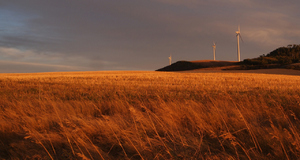Cost-Effective Renovations and Other Improvements for Creating More Energy Efficient Homes
By
2009, Vol. 1 No. 10 | pg. 1/1 Just by flipping through television channels or walking through the aisles of a grocery store, it is easy to see that the popularity of “Green” and “Sustainable” lifestyles is growing everyday. With an impending energy crisis on our hands, people want to find ways to reduce their energy consumption, and a major benefit of that is saving money on energy costs. People who want to make their home more energy efficient need to understand that it can be done without “going green”. On the Planet Green channel there are shows like Greenovate or World’s Greenest Homes that showcase homes that are (or are in the process of becoming) Green and Sustainable. The problem with these shows are that they show people who have budgets of anywhere from $40,000-$100,000 and even more than that sometimes, and a good amount is spent on sustainability. The idea that you can only have an energy efficient home if you spend a ton of money is perpetuated by these shows. Making your home more energy efficient can seem like a daunting and expensive undertaking, but it doesn’t have to be. If one decides to focus only on energy efficiency, they can make cost-effective decisions about the changes that they will make to their home. The goal here is not to discourage sustainable living, but to let people know that they can create an energy efficient home without spending more on all the bells and whistles that go along with sustainability. By knowing the small things that can be done, the larger-scale renovations, knowing how to use the environment around you to save energy, and differentiating between efficiency and sustainability will save money and reduce the impact a home makes on the environment. There are a few simple things that can be done in one’s home to immediately begin reducing energy costs. There are the obvious things, such as turning out the lights when leaving a room or keeping the air conditioning around 72°-76° in the summer and in the mid-low 60’s in the winter (or whatever makes the most sense according for the local climate). An air conditioning unit running at 65° in the summer or 80° in the winter will cause the utility bill to skyrocket. When using the refrigerator, deciding what is needed before opening the door rather than perusing through while the cold air rushes out can save a good amount in electricity. These things are all common sense and only require awareness and will power.Other simple things that can be done to improve energy efficiency in the home are replacing incandescent light bulbs with compact fluorescent lights (CFLs). Incandescent lights produce a lot of heat and use a lot of energy. CFLs can produce an equivalent amount of lighting while using much less wattage and last much longer. A standard incandescent light produces 13 lumens per watt and have a lifetime of 1000 hours. A compact fluorescent produces 60 lumens per watt with a lifetime of 7,500 hours (Harland 1999:89). Using the light from the outside can reduce how much electricity is needed to light a house. Light reflects more off lighter colors than dark colors, so painting walls and ceilings light colors also allows for the lighting to reflect better (Smith 2004:71). White walls will have a .85 reflectance (85% of light will be reflected), while a lighter color like yellow or cream will have a reflectance of around .65, and a dark color will only reflect 20% of the light (Thomas 1996: 98). For windows that allow significant heat transfer, dark, thick curtains or shades can be used to limit the amount of heat lost from or absorbed into the house (Scheller 1979:136). Make sure that doors and windows have a snug, airtight fit. If not, apply weather stripping to the edges of doors and windows, and apply caulk to any cracks around window seals (Chiras 2004:58). Air filters need to be cleaned regularly and should be replaced about once a year to keep air conditioning units running efficiently (Scheller 1979:118). While cooking, smaller items can be cooked in a toaster oven instead of the full-sized oven. Leaks account for 14% of water use in residential buildings, so tightening the pipes is an easy way of saving money (Wells 2007: 47). Save even more water by installing showerheads that use less water. These are things that can be done for little or no cost and can have significant effects on an electric bill. Home renovations can be very costly, but knowing exactly what needs to be done to lower energy costs can help one make informed decisions. Having a home energy audit either by the homeowner or a professional can be very helpful in determining what can be done to improve energy efficiency. These audits focus on weatherization, or weatherproofing, which protects a home from the outside elements. The audit results can help one decide what type of weatherization renovations may be needed. The average cost of work done is $2,500. On average, savings are 2.2 times what is spent on weatherization (DOE 2009). Whether the audit is done by the homeowner or a professional, a very common fix is applying or replacing insulation. Good insulation can reduce an energy bill dramatically, and if a home was built with poor insulation, new insulation could reduce air conditioning costs up to 50% (Smith 1999:7). There are many different options for insulation, each providing their own benefits, and since all homes and climates are different, it is up to the homeowner to decide which type of insulation is the best fit. Insulating the attic, in between walls and under floors are very effective in preventing the outside temperature from influencing the temperature inside of the house, and is usually less than $2 per square foot. An audit may reveal that the siding or roofing of the house needs to be replaced. Siding and roofing can be even more important than insulation because the less heat that makes it through the roof or siding, the less heat the insulation needs to keep in. Insulated windows and frames are effective in keeping the cold out in the winter and the heat out in the summer. Double-paned, glazed windows can go a long way in preventing heat transfer into and out of the house. These windows can also reduce UV damage to carpet or furniture exposed to the sunlight (Chiras 1999:78). An auditor can also determine whether a house’s water heater is running efficiently. Most newer heaters are efficient enough, but an older house may be losing a lot of money due to inefficient water heating. A water heater comprises 11% of electricity use, so replacing an inefficient heater can save money in the long run. There are also many appliances on the market that are energy efficient, but some are more so than others. Appliances account for about 20% of household electricity consumption in America and 14% of this comes from dryers, refrigerators and washing machines alone. Depending on the budget, it may be worthwhile to purchase an energy efficient washer, dryer and/or refrigerator. While purchasing appliances, always look for the Energy Star ®-certified products, which are usually in the top 25% of their product’s class in energy efficiency. While they are a little more expensive, efficient appliances can save $200+ a year in electricity and water, which will add up over several years (Wells 2007:44-5). Using the environment around the house to your advantage is another way to save on energy costs. Investing in solar panels is one way to do just that. Photovoltaic (PV), also known as solar cells, convert the sun’s rays into electricity. PV systems are pretty expensive, ranging from $30,000 to $70,000 for average units, and even more for the higher end models, but they can offset 40-90% of a home’s electricity use. State rebates and federal tax exemptions will reduce the cost of PV units, and some municipalities and power companies will buy power that is created from a unit on the grid from the owner for competitive prices. PV systems can also be leased or taken out against a mortgage (Wells 2007:45). If used in an area with a good amount of solar energy that can be absorbed, a Photovoltaic system can save a homeowner tens of thousands of dollars over a twenty-five year period. Installing skylights is an aesthetic improvement that also lights up a room very well on a sunny day. There are many different varieties of skylights to choose from, each with different benefits, but they all provide light to a room that normal windows usually can not, making artificial light unnecessary in good weather (Higson 1977 :43-44). Depending on how far a homeowner wants to go, an energy efficiency makeover can get very pricey, and avoiding unnecessary items labeled green or sustainable can mean the difference in thousands, or ever tens of thousands of dollars. Much can be said for sustainable living, but if the ultimate goal is saving money, then sustainability doesn’t always make sense. When making decisions on any product, the most important question that needs to be asked is “How will this product reduce energy consumption?” Insulations that use recycled materials are nice, but if the price a lot higher than normal insulation of comparable quality, it may not be the best way to spend your money. When it comes to building materials, there are many expensive sustainable options for home improvements such as bamboo floors, recycled carpets, or concrete counter-tops, but unless it is necessary to replace such items, then why not keep what is already there? That seems to be more sustainable than purchasing new items. And if something does need to be replaced, do not feel forced to go for one of these expensive options, as doing so will not help reduce energy costs. Rain catchment systems seem like a good way to conserve water, but the cost of the system and hooking it up to the home’s water supply is costly and does not provide much in the way of savings. Remember that if the goal is to save money, purchases must be well researched. Do not just rely on labels and claims that can be, and often are misleading. Needless to say, any sustainable options that costs the same or nearly the same as other options are encouraged and most likely helping out the environment and is a novel thing to do, but reducing energy consumption will have a far greater impact on the environment. By doing some or all of the things laid out here, whether it be the small things, the renovations, maximizing the solar energy available or just being smart about what will help save money, the monthly utility bill will be less and less. Reducing energy consumption is ultimately reducing the amount of energy that is needed from power plants, thus reducing greenhouse gas emissions and other harmful side-effects to the environment around us. Therefore, creating an energy efficient home benefits not only the homeowner, but the Earth as well. Harland, Edward. Eco-Renovation: The Ecological Home Improvement Guide. White River Junction, VT: Chelsea Green, 1999. Higson, James D. Building and Remodeling for Energy Savings. Solana Beach, CA: Craftsman, 1977. Scheller, William H. Energy Saving Home Improvements. Indianapolis: Howard W. Sams & Co., 1979 Smith, Peter F. Eco-Refurbishment: A Guide to Saving Energy and Providing Energy in the Home. Burlington, MA: Architectural Press, 2004 Thomas, Randall. Environmental Design: An Introduction for Architects and Engineers. London: E & FN Spon, 1996. Wells, Walker. Blueprint for Greening Affordable Housing. Washington, DC: Island, 2007 Chiras, Daniel D. The New Ecological Home. White River Junction, VT: Chelsea Green, 2004. Weatherization Assistance Program. U.S. Department of Energy. 24 Mar. 2009. Suggested Reading from Inquiries Journal
Inquiries Journal provides undergraduate and graduate students around the world a platform for the wide dissemination of academic work over a range of core disciplines. Representing the work of students from hundreds of institutions around the globe, Inquiries Journal's large database of academic articles is completely free. Learn more | Blog | Submit Latest in Economics |


















